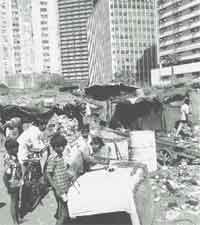Unfriendly neighbourhoods
 india , in the post-Independence era, has managed to be self-sufficient with regard to food and clothing. However, provision of adequate housing to the growing population has been a persistent dilemma.
india , in the post-Independence era, has managed to be self-sufficient with regard to food and clothing. However, provision of adequate housing to the growing population has been a persistent dilemma.
Indian cities are merely growing, decade after decade, rather than developing. With a regular influx of migrants to cities, even residents find it difficult to get accommodation. For the poor migrants, finding accommodation becomes a nightmare. As a result, there is a rapid growth in slums.
Despite the plethora of codes and regulations, there is little impact on the quality of the built environment. Each new code has forced people to mould spaces to suit their own way of life. This abuse of space has exposed the growing gap between designer and user.
Meeting the shelter needs of the growing population is not merely a matter of number of dwelling units and the funds required for the programme.A broader and comprehensive outlook is necessary to ensure qualitative aspects related to individual and community identity, security, and wellbeing.
A vast majority of the population in urban areas can barely meet its daily needs. A pucca house with own land, building and adequate amenities is, and will remain, a dream for the majority of our urban population unless concerted efforts are made for the urban poor. The few who can afford a shelter of their own face an equally serious problem in having to accept an environment ill-suited to their lifestyle.
Even the major urban centres, despite their significant contributions to the national economy, present a dismal picture, with rapid proliferation of slum settlements, congested streets, inadequate public transport systems, growing unemployment, lack of access to basic services like drinking water and sanitation, inappropriate urban management, and growing civic disturbances. The result of all this is a continuous decline of the quality of life in cities today.
Ancient architecture and town planning techniques that are reflected in the traditional settlements indicate an efficient deployment of scarce resources suited to the then prevailing culture and lifestyle.
Contemporary codes and regulations have an overwhelming concern for the health and physical safety of the residents. However, the resulting built environment has little to do with identity, sense of wellbeing, man's relationship to nature, feeling of neighbourliness, and a sense of security.
Unfortunately, urban development is in the hands of a few large-scale developers and local public agencies are unable to cope with provision and maintenance of even basic services. At the same time, the role of professionals - planners and architects- is gradually becoming restrictive and myopic as they, through ineffective controls, either contribute or remain silent witness to the degradation of the quality of the built environment.
The primary goals of human habitat development should be resource conservation and harmony with traditions. The basic resources of human habitat - such as land, water, building material and energy - are finite. Design practices that are wasteful or oblivious to the resource impact of the built environment, will have to give way to conservation and recycling of these resources.
Designers and planners are more a part of a universal professional culture than the local culture for which they design or plan. Their identity with a placeless culture and a lack of understanding of the local setting has made them indifferent to their roots. It is, therefore, necessary that the planning and design profession in India search for an ideology that derives from the roots of traditional settlement design practices in this sub-continent.
B V Doshi is director and Utpal Sharma is senior architect planner of Vastu-Shilpa Foundation, Ahmedabad.
